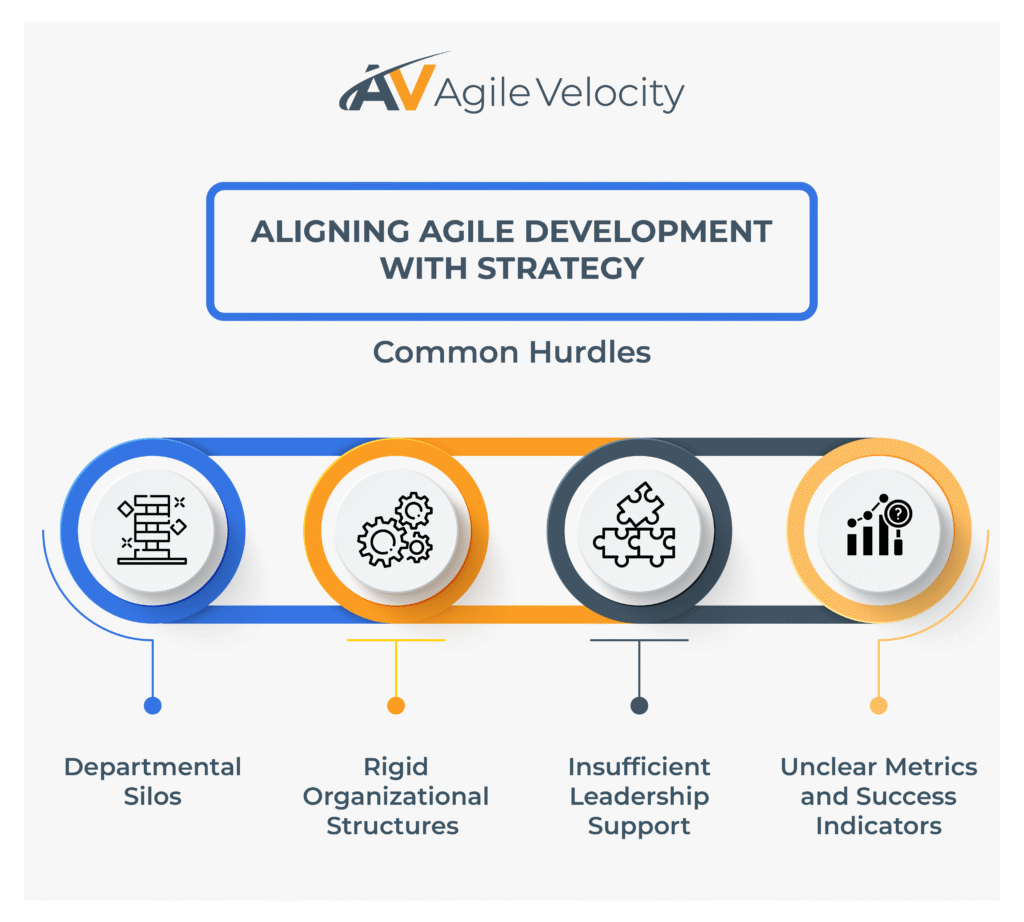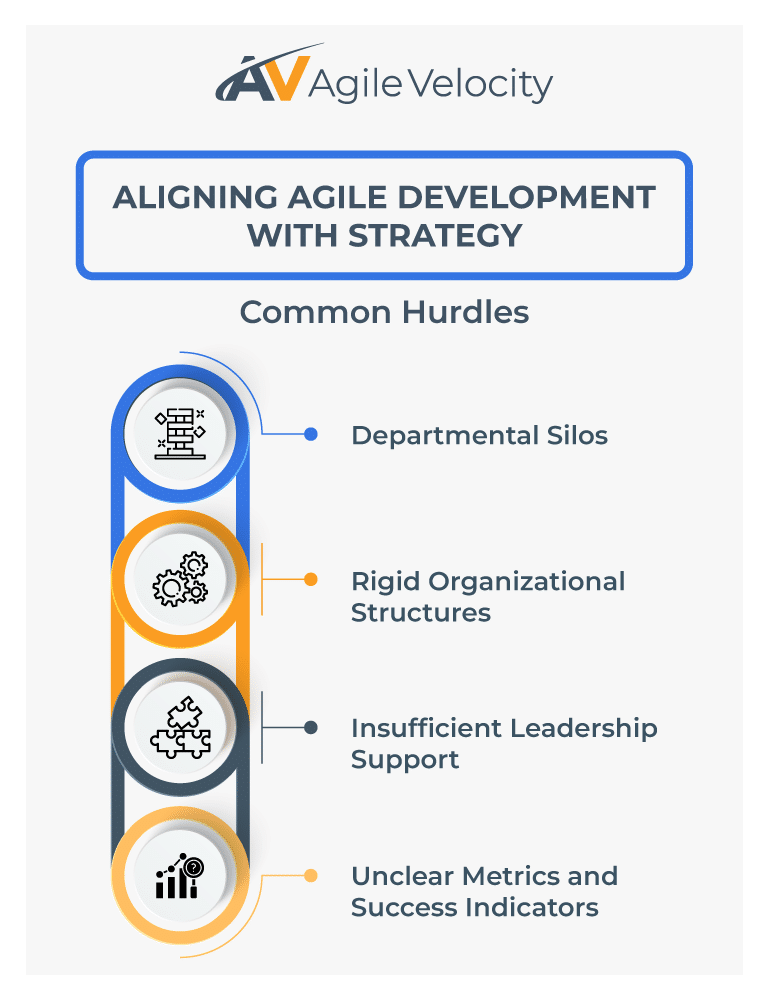Integrating strategy with Agile development drives more than just efficiency—it fosters adaptability, cross-functional collaboration, and clarity of purpose. With strategic alignment, teams not only deliver faster but also ensure that their efforts reflect the organization’s most important objectives. Ultimately, organizations gain the flexibility to respond to external changes and internal shifts while maintaining focus on delivering meaningful outcomes.
In this article, we’ll uncover how aligning Agile initiatives with business strategy enhances team performance, streamlines decision-making, and accelerates value delivery. We’ll also explore actionable principles and innovative tools that enable businesses to bridge strategy and execution effectively. By creating this cohesion, organizations can achieve sustained innovation, meet market demands more nimbly, and drive exceptional performance at all levels.
Unlocking the Full Potential of Agile Strategy Integration
Agile is a powerful way to deliver value with speed and predictability. But while speed is valuable, focusing on velocity alone without tying outputs to strategic goals can result in a disconnect that diminishes impact. For Agile development to drive maximum effectiveness, it must align with the broader vision of the organization, ensuring that day-to-day efforts collectively support long-term success.
When Agile practices are aligned with business strategies, organizations can maintain flexibility while improving collaboration across teams. They also sharpen focus on delivering high-value outcomes. This alignment instills a shared purpose, enables individuals to make informed decisions, and boosts overall productivity by reducing wasteful or redundant activities.
Below, we’ll examine the significance of merging strategy with Agile practices. We’ll look at how Agile Transformation initiatives, targeted techniques, and a culture of continuous improvement successfully connect execution with top-level strategy. We’ll also see how a software called Path to Agility Navigator can provide a clear line of sight between tasks and larger business outcomes, enabling teams to adapt quickly while consistently driving measurable returns.
The Importance of Integrating Strategy with Agile Development
Every organization has a strategy that charts its path forward. However, even carefully designed strategies can falter when teams that adopt Agile practices operate without considering overarching business aims. Efforts might be efficient and iterative, yet still fail to align with high-impact objectives or market demands.
Bringing strategy into harmony with Agile development ensures teams deliver value that genuinely supports long-term goals. By bridging the gap between vision and execution, companies foster greater clarity of purpose. Teams can prioritize high-return initiatives, eliminate redundant effort , and allocate resources wisely.
A few benefits of strategically integrated Agile workflows include:
- Focus on High-Value Work: Guidance on which tasks drive substantial business impact.
- Cross-Functional Collaboration: Synchronizes departments, reducing silos and boosting shared outcomes.
- Informed Decision-Making: Enables rapid choices without losing sight of strategic direction.
- Enhanced Transparency: Provides leaders and teams visible connections between everyday activities and top-level priorities.
Ultimately, effective alignment underpins organizational agility. While Agile teams concentrate on iterative work (such as Sprints in Scrum or Iterations in SAFe®), true value emerges when these short-term cycles are grounded in the company’s strategic blueprint. This unity empowers organizations to remain flexible and forward-thinking, delivering continual progress against ambitious objectives.
Understanding Strategic Alignment in an Agile Context

Strategic alignment in Agile means ensuring every task, event, and product increment contributes to overarching goals. Without this, teams can churn out outputs that, although completed quickly, neglect broader targets.
In an Agile environment, alignment bridges vision and reality. It gives teams transparency around what matters most, so daily work is always significant and influential. Often, this connection is reinforced by higher-level portfolio planning that translates overarching strategies into team-level priorities. By backing teams with purpose and direction, Agile becomes a true vehicle for continual, strategic value delivery.
Key facets of alignment in Agile development include:
- Defined Goals: Everyone understands the “why” behind each initiative.
- Prioritization of Strategic Value: Stakeholders focus on items that produce the greatest impact.
- Feedback Loops Across Levels: From Sprint Review events to cross-team sessions, regular touchpoints keep everyone aligned.
- Flexibility to Adapt: Both strategy and execution evolve together, accommodating new insights and changing conditions.
When teams see how their Iterations or Sprints reinforce big-picture ambitions, they collaborate more effectively and foster a culture of ownership. Leaders can break broad strategies into achievable deliverables, and teams can iterate toward tangible milestones that move the business forward.
Common Barriers to Aligning Agile Development with Strategy
Despite the clear advantages of linking Agile development with organizational goals, many businesses stumble due to structural or cultural constraints. Some frequent hurdles include:
- Departmental Silos: Independent departments often have divergent agendas. This disjointed approach undermines coordination and wastes effort that could otherwise drive top-level priorities.
- Rigid Organizational Structures: Traditional hierarchies can slow decision-making and block cross-team collaboration, making it tough to pivot swiftly or maintain shared direction.
- Insufficient Leadership Support: Leadership sponsorship is essential for any change management effort. Without it, teams may lack the backing and resources they need to converge on strategic outcomes.
- Unclear Metrics and Success Indicators: Teams cannot evaluate progress effectively if they lack clearly defined measurements that tie back to strategic goals.
Addressing these issues involves both cultural and organizational changes. Businesses must nurture open communication, promote transparency in how decisions are made, and establish frameworks that consistently tie lower-level tasks to high-level ambitions.
5 Key Principles for Connecting Strategy and Agile Development
Successfully fusing strategy and Agile development calls for a set of principles that promote collaboration, adaptability, and clarity. When these are consistently applied, leaders and teams can stay aligned with broader goals while quickly adapting to shifting realities.
Here are five essential guidelines:
1. Leadership Shapes Culture and Priorities
Leaders who champion openness, values, and transparent communication pave the way for seamless strategy integration. They model Agile behaviors and encourage continuous feedback, ensuring everyone recognizes why strategic alignment is vital. This approach reduces bottlenecks and steers teams toward impactful outcomes.
2. Focus on Value Streams for Prioritization
Using value streams helps organizations map how an idea moves from concept to creation. This ensures that time, resources, and budget are invested where they’ll deliver the most significant return, strengthening ties between daily work and the company’s long-range success.
3. Synchronize Planning to Agile Cycles
Traditional, lengthy planning processes can hobble an organization’s agility. Instead, coordinating strategic planning with shorter cycles—like Sprints or Iterations—helps businesses adapt initiatives as fresh data surfaces. By periodically reassessing priorities, companies remain focused on achieving real results, rather than clinging to outdated plans.
4. Embrace continuous improvement
Regular reflection, including events such as Sprint Retrospective, allows teams to spot what’s working and pivot if needed. Encouraging small, iterative enhancements ensures the organization can keep evolving its approach without losing sight of broader goals.
5. Empower Teams to Act with Autonomy
Teams make better, faster decisions when they understand the strategic “why” behind their work. By reducing micromanagement and supporting continuous integration efforts, leaders preserve momentum while ensuring every move aligns with the company’s overall vision. This autonomy nurtures ownership, motivation, and accountability.
By following these principles—supported by open leadership, value-centric priorities, iterative planning, a spirit of continuous improvement, and empowered teams—organizations establish a solid link between their objectives and the work that moves those objectives forward.
Agile Practices and Tools for Strategic Integration
Bringing Agile development into harmony with a company’s larger mission calls for targeted practices and tools that keep teams synchronized with strategic priorities.
Below are some powerful options:
Lean Portfolio Management for Strategic Decision-Making
Lean Portfolio Management organizes the flow of work to mirror strategic goals. Leaders can weigh ongoing projects based on their contributions to the company’s vision and redirect resources where they matter most. By focusing on high-priority items, businesses cut down on wasted effort and remain committed to growth.
Agile Coaching as a Guiding Resource
Adopting Agile at scale often involves a deep cultural shift. Agile Coaching provides a supportive blueprint that helps teams use new frameworks while staying true to strategic goals. Coaches assist teams as they establish new rhythms, refine collaboration, and build the confidence to pivot rapidly when market conditions change.
Scaling Agility with SAFe
When organizations expand, they must adapt their execution to avoid confusion or duplication. The Scaled Agile Framework® (SAFe) supports broader strategic integration by defining roles, events, and responsibilities that keep multiple teams aligned. Artifacts like the Agile Release Train (ART), checkpoints for the Business Owner (BO), and established Planning Intervals offer essential visibility into how each moving piece supports top-level targets.
Path to Agility Navigator for Transformation Precision
Enterprise-wide Agile initiatives can be complex, requiring clear visibility into progress and priorities. Path to Agility Navigator is a continuous improvement software that helps organizations:
- Visualize areas for optimization that keep teams aligned with strategic objectives.
- Track and gauge improvement toward long-range goals.
- Define targeted actions so all development work remains purposeful.
Users gain up-to-date dashboards and progress indicators that combine data across the enterprise. This big-picture view ties iterative achievements to overarching aims, ensuring each initiative contributes to sustainable success while still allowing room for rapid course corrections.
Individually or combined, these tools and practices foster synergy between Agile processes and strategic ambitions. They preserve the iterative flexibility of Agile without sacrificing the guidance and focus that come from a strong business plan.
Building a Culture of Collaboration and Innovation
Strong alignment between Agile development and strategy thrives in an environment where transparency, collaboration, and inventive thinking are celebrated. By shaping this culture, organizations deepen engagement and unlock creative solutions that reinforce strategic priorities.
Consider these approaches:
- Encourage Cross-Functional Collaboration: Forge connections between departments, so each effort benefits from varied expertise. This pooling of knowledge drives more robust solutions aligned with the company’s strategic outlook.
- Promote Transparency at All Levels: Employ visual boards, such as a Kanban Board, to highlight both progress and obstacles. When everyone can see how certain tasks contribute to the broader vision, teams remain energized and focused.
- Celebrate Strategic Wins: Linking achievements to organizational milestones sustains enthusiasm. Recognize team and individual successes, reinforcing the significance of each person’s role in pushing strategic outcomes forward.
- Foster Psychological Safety: Encourage open communication and treat missteps as learning moments. This environment boosts confidence in experimentation—fuel for innovation and quicker adaptation.
- Embed Learning and Professional Growth: Offer training on Agile frameworks such as Large-Scale Scrum (LeSS) and Disciplined Agile® (DA™). By showing teams how these approaches relate to strategic goals, your workforce gains agility.
- Leverage Feedback Loops to Drive Innovation: Each Sprint Review and Sprint Retrospective reveals valuable data on progress and direction. Use this feedback to guide enhancements that reinforce alignment and stimulate creativity over time.
By nurturing these cultural elements, businesses create an adaptive workforce that remains steadfast in achieving strategic objectives. Teams feel motivated, leadership sees tangible results, and customers receive products and services that map directly to the company’s mission.
Benefits of Aligning Agile Practices with Strategic Objectives
Genuine alignment between Agile methods and business aims triggers significant advantages throughout the organization.
These benefits include:
- Improved Predictability – Tying daily work to well-defined outcomes clarifies direction, making it much easier to forecast results and plan effectively.
- Accelerated Value Delivery – Focusing on the most impactful initiatives increases delivery speed and ensures that resources fuel the highest-return activities.
- Enhanced Adaptability – When short-cycle events—like Sprints in Scrum—mirror strategic objectives, teams pivot smoothly in response to new information while staying on track.
- Empowered Teams and Leadership – Clear shared goals motivate teams to take responsibility for finding the best solutions. Leaders, in turn, can set meaningful boundaries and direction without micromanaging.
- Improved Customer Satisfaction – Agile frameworks highlight client and end-user feedback. By sticking to strategic goals, you continually refine your product in ways that meet customer expectations and reinforce loyalty.
- Sustainable, Long-Term Performance – Aligning Agile work with high-level planning creates lasting gains rather than sporadic success. Strategic alignment, paired with iterative improvements, results in an organization ready to thrive in changing markets.
Practical Steps to Foster Strategic Alignment

If achieving top-level outcomes through Agile development sounds complex, organizations can build alignment in manageable steps.
Here are some practical suggestions for the journey:
1. Break Down Strategy into Clear Themes
Translate your strategy into defined areas—like boosting customer retention or diversifying product lines. By mapping tasks back to these central themes, teams can quickly see how their work drives overarching ambitions.
2. Embrace Iterative Planning Cycles
Swap static, long-term forecasts for shorter cycles—monthly or quarterly—to keep strategy in sync with reality. This ensures you can respond promptly to fresh data and maintain a healthy balance between short-term pivots and large-scale targets.
3. Regularly Refine Backlogs
Backlogs, including the Product Backlog in Scrum, shouldn’t be treated as static lists. Ongoing refinement keeps them relevant and aligned with shifting priorities or market trends. Include stakeholders in backlog refinements to enhance strategic alignment.
4. Use Visual Tools for Transparency
Leverage Kanban Boards, dashboards, or Work In Progress (WIP) Limits to illustrate progress in real time. Public visualization of goals and tasks helps everyone see who’s doing what—and why it matters.
5. Prioritize Learning and Skill Building
Offer targeted coaching and training through things like workshops and coaching sessions. This empowers teams to adapt quickly, helps standardize vocabulary around Agile, and strengthens alignment across the board.
6. Make Data-Driven Decisions
Analyze success metrics—like customer satisfaction scores, lead times, or revenue lifts—to confirm Agile practices are producing tangible benefits. If the data indicates a mismatch, use Agile events to inspect and adapt as needed.
7. Hold Strategic Alignment Retrospectives
Team up with colleagues, Agile Coaches, and business leaders for periodic discussions on whether efforts still mirror strategic plans. Revisit objectives, measure progress, and fine-tune the roadmap.
With these methods, organizations connect ground-level Agile tasks to the loftiest company goals. By staying flexible while honoring strategic directives, teams can deliver faster, adapt confidently, and contribute meaningfully to their organization’s mission.
Enhancing Agility with Artificial Intelligence and Emerging Practices
Beyond the core techniques above, emerging technologies like Artificial Intelligence (AI) can elevate Agile development. AI-powered analytics can help teams spot bottlenecks, automate mundane processes, and forecast risks. Implementing AI must align with the company’s strategic pillars—otherwise, it becomes just another siloed tool. By weaving AI into Agile structures, leaders gain data-driven insights that inform priorities, making the entire organization more nimble and productive.
Meanwhile, many businesses now explore flexible work models—such as remote or hybrid setups—and orchestrate return to office events to balance in-person collaboration with remote capabilities. In all of these shifts, shared goals and transparent communication remain paramount to keep teams unified and on mission.
Organizations can also utilize Agile staffing services to quickly bring on valuable talent and scale teams up or down based on immediate needs. This approach grants flexibility to meet evolving priorities and maintain momentum without lengthy recruiting processes.
By thoughtfully weaving these emerging approaches and technologies into your existing Agile framework, you reinforce strategic focus and collaboration—two cornerstones for enduring success.
Taking Agile Strategy Integration to the Next Level
Aligning Agile development with your organization’s strategy is vital for ensuring lasting competitiveness and relevance. By linking day-to-day outputs to long-term goals, businesses improve collaboration, accelerate value delivery, and become more adept at navigating continuous changes.
Tools such as Path to Agility Navigator, combined with Lean Portfolio Management, targeted training, and short-cycle planning, offer practical ways to track progress and confirm your Agile outputs remain on target. Every release, Sprint, or Iteration becomes part of a broader pursuit of sustainable growth and innovation.
If your enterprise is ready to strengthen its Agile approach and cement lasting strategic alignment, Agile Velocity can help. From Agile Coaching to specialized frameworks and hands-on transformation support, our experts partner with you every step of the way. Schedule a consultation with Agile Velocity today to chart your path toward higher performance, deeper collaboration, and sustained organizational agility.





